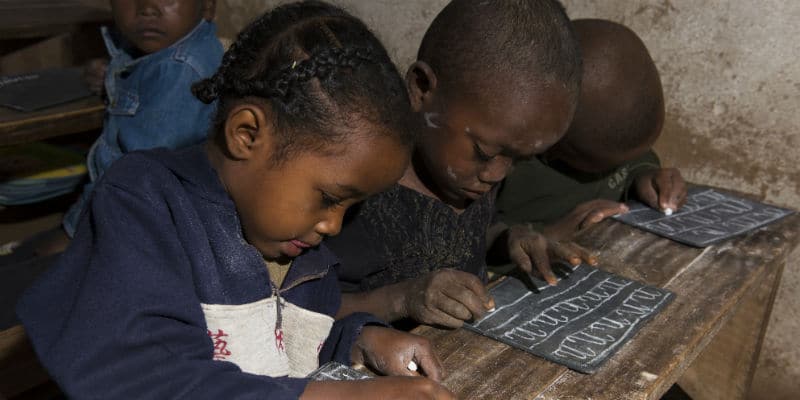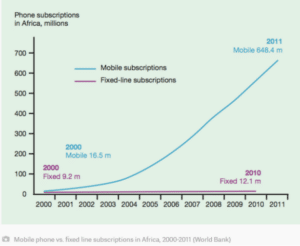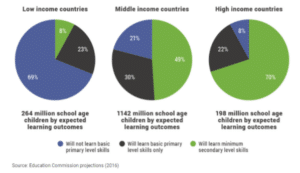Today, there are more than 750 million mobile phones in operation in Africa. The telecommunications industry generated more than $150 billion in revenue in 2015 and accounted for over 3.8 million jobs. But barely 20 years ago, there were fewer than 10 million phone lines on the continent, with a majority of working lines in South Africa.
Looking back, it is easy to under-appreciate the proliferation of mobile telephony and the attendant benefits that come with it. But what happened was nothing short of a miracle. The sort of miracle that can only happen when innovation and technology are at the core of a mass proliferation strategy. The same thing can happen in the education sector in Africa, a sector in desperate need of a miracle if Africa is to achieve prosperity in the next few decades.
Africa’s education (and money) problem
Africa’s not alone in its struggle to educate its people. But no other region in the world has it worse, especially as the continent’s population continues to explode. In 2012, of the 58 million children who were not enrolled in primary schools, 38 million were in Africa. Nine of the ten countries with the highest rate of out-of-school children are in Africa. By 2050, Africa will be home to more than 2.4 billion people, up from 1.1 billion today. But even then, only one in three children will have access to secondary school.
It does not take a rocket scientist to imagine what is bound to happen when you have at least a billion youth, many of whom are uneducated, and most of whom have little to no economic prospects. Incidences of crime, mass migration, and terrorism-related activities are bound to increase.
Many organizations are committed to addressing this problem, but funding education in Africa the conventional way—spending hundreds of billions of dollars to build thousands of schools and hire millions of teachers—is too slow. It is akin to digging in the ground and fixing millions of miles of cables in order to outfit the whole country with landlines. Not only is it very slow, it is also prohibitively expensive.
For example, it will cost sub Saharan Africa more than $4 billion in salaries alone if the region is to achieve universal primary education. Adding up all the costs for building, and maintaining primary schools, the cost balloons to $26 billion. This does not include secondary schools or universities. In addition, this does not take into serious consideration the quality of education the students will get. This is where innovation and technology can play a role.
Innovation is simply the process by which we create practical solutions to actual problems. And technology is the process by which we convert inputs of lesser value into outputs of greater value. When both definitions are considered, it becomes clear that many of the solutions to build thousands of classrooms all across Africa are neither innovative nor technological. Research by Harvard’s Lant Pritchett, chronicled in his book, The Rebirth of Education, exposes that many students who attend primary schools in poor countries are unable to read, write, or do basic arithmetic by the time they graduate.
In Nigeria, this problem is all too prevalent. Children enrolled in school learn in buildings that are replete with decaying infrastructure, dilapidated classrooms, and outdated libraries, if they are lucky to have one. Private schools are too expensive for the average Nigerian, with a per capita income of around $180 per month. In addition to all this, over the past few years just around 50% of students pass the secondary school exit exam.
A Nigerian tech company, Passnownow.com, is a potentially disruptive solution that could fundamentally transform the education sector in Nigeria and most other countries in Africa. Passnownow.com’s mobile learning platform has digitized Nigeria’s entire high school curriculum and offers it at roughly 25 cents per class to students, teachers, and parents. In addition, the platform offers a syllabus with class notes and practice questions that are compliant with national standards. It also leverages the proliferation of mobile phones in Africa and offers an accessible mobile user interface. Passnownow.com’s solution to education will drastically reduce the cost of learning on the continent, and will attract millions of Africans who still live in rural areas.
Of course, Passnownow.com’s e-learning solution cannot substitute learning in a school with excellent teachers and resources. Disruptive Innovations are not breakthrough technologies that make good products (in this case, top schools in Nigeria) better; rather they are innovations that make products and services more accessible and affordable, thereby making them available to a larger population.
Thus, rather than compete head on with quality schools, the mobile platform is focusing on students who are grossly underserved by the existing education offerings, since its solution is better than the alternative (subpar education, or potentially no school at all). It’s important to note, however, that while Disruptive Innovations they may start at the bottom, they ultimately work their way up, becoming better and better until they’re able to compete with industry leaders. It is quite conceivable that Passnownow.com’s offerings could become just as good as those offered in private schools—and cost far less.
This is the same thing that happened with mobile phones in Africa. When they were first introduced, the call quality was not as good as landlines; dropped calls were all too common as there was very limited coverage across the continent. But over time, the service got better and better, and Africa found itself without the need to invest in landline technology.
It is Disruptive Innovations like these that have the potential to change the trajectory of development for Africa since they increase access by reducing costs. What if more resources went to developing innovations such as these for other sectors, such as electricity and healthcare?





